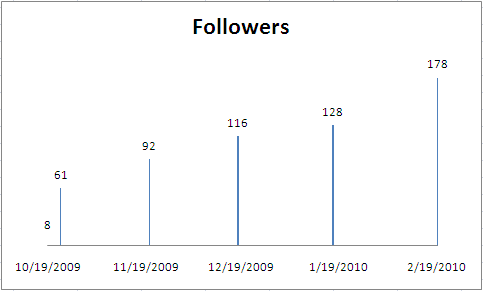CDL’s Twitter account, Part 2
In an earlier post , I promised I’d cover our Twitter guidelines and also provide you with some information about how the account is performing. Before I get going, let me remind any readers unfamiliar with Twitter that “following” is a Twitter term for subscribing to the brief broadcasts of information, links, and so forth that Twitter users send, called “tweets.”
First up: our guidelines. When we decided that CDL’s central account would follow CDL individuals, there was some concern that we would end up with content like “I’m taking out the trash” or “I just saw the most amazing [fill-in-the-blank]” in CDL’s Twitter stream.
So, we agreed that a very small number of guidelines would be useful. We read the LowriderLibrarian post about using Twitter for organizations, and we drew inspiration, if not detail, from it. We used a wiki to write down our ideas, comment on each other’s changes, and tweak (and re-tweak). In the end, here is what we came up with:
Group account: When you are tweeting from a group account (e.g. eScholarship, Calisphere, Discovery & Delivery, CDL_WAS, etc.), remember that you are representing CDL and the University of California.
Individual account: If you choose to be followed by the CDL as an individual tweeter, remember that your comments will reflect on CDL. Think of this as your professional persona; the viewpoints and topics you express should be primarily professional in nature. If you want to use Twitter primarily to express your personal views and discuss personal topics, maintain a separate personal account for this purpose. (Optional: you may identify yourself as a CDL employee in your Twitter profile, i.e. in the bio or the username.) Note: CDL reserves the right to stop following any individual account at any time.
In general: remember that your tweets may be forwarded and shared by others in the Twitter community–in fact, we hope they will be!
At this point, only 6 individual CDL employees have chosen to be followed by the central CDL account, so it may be the case that the personal/professional guideline didn’t quite hit the mark. Stay tuned.
As for assessing the performance of CDL’s Twitter presence, I’ll organize this information in terms of how it addresses our original reasons for setting up the Twitter account.
Our first goal was to gain a new way to get our newsletter, CDLInfo, out into the world. To test whether or not this is succeeding, I’ve done a little comparison between the email list of subscribers to CDLInfo with the Twitter account’s followers and asked, “Is Twitter helping us to reach new people?” The results of the comparison are that only 5% of the Twitter followers appear to be duplicates of the email list members, with another 8% having Twitter names that make them unidentifiable, so that the ratio could conceivably rise to as high as 13%.
Our second goal was to amplify the voices and messages of the accounts it follows. This is more true for some accounts than others. For the Twitter accounts with fewer followers than CDL–178 at the time of this writing–CDL’s reach absolutely makes a difference in getting the word out. I have also been tracking CDL’s performance using a tool called Twitalyzer (http://www.twitalyzer.com/) over time, although Twitalyzer is normed against some very large “power users.” Twitalyzer has defined two metrics that have some relevance for this amplification notion: “Influence” and “Clout.” Influence, as they define it, is “measured by the number of times you are retweeted.” Retweeting takes place when another Twitter user forwards one of your tweets. Clout is “simply the number of references to you divided by the total number of possible references (as governed by the Twitter Search APIs).” To date, CDL’s measures against both of these metrics are very low.
Our third goal was to increase CDL’s visibility, in concert with our values of openness and sharing. In order to assess the account’s performance against this goal, we have two sources of information. On the one hand, we can look at the WordPress website statistics and ask whether or not Twitter, in general, and the CDL Twitter account specifically, is sending traffic to the CDLINFO page. In addition, we can ask whether or not the CDL Twitter account is gaining in popularity, thereby providing a net increase in the number of readers for CDLINFO.
For the past 30 days, Twitter.com is the top referrer to the CDLINFO page. Twitter.com/caldiglib is the 4th highest referrer for the same period. And, since its inception, in October, the CDL Twitter account has gained followers steadily, as the chart above shows. The distinction between Twitter.com and Twitter.com/caldiglib as referrers can be explained in this way: this is the difference between someone following a link from his or her own Twitter home page, which appears as http://twitter.com, or that same person visiting CDL’s Twitter home page, which appears as http://twitter.com/caldiglib.
To sum up, then, CDL’s Twitter account is getting the CDLInfo newsletter to new people and increasing CDL’s visibility generally.

